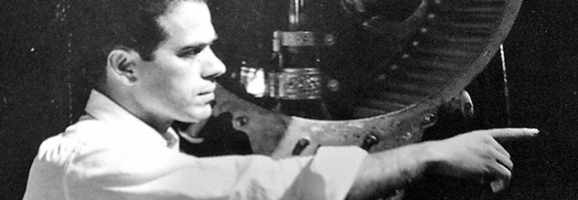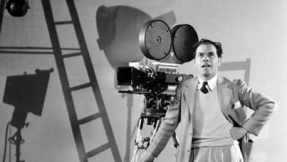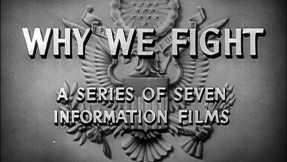Frank Capra: Finding His American Identity Through Film

Today, Frank Capra is celebrated as one of the most influential and important directors of the last century. What makes Frank Capra so enigmatic in American culture is his impact in film that has crossed boundaries and infiltrated various aspects of society, such as politics, family values, and patriotism. Capra’s vision for America was the belief that community was one of the most important aspects of life and it was the duty for the common man to defend the rights of those incapable. His films, many of which have stood the test of time, have been held as institutions in our culture and are staples in numerous Top Film lists. However, his popular status has wavered throughout his career, spanning from being one of the most popular filmmakers in the country to all near losing his relevance as an artist. Criticized for the themes featured in his films, Capra was a diehard patriot. Capra’s version of the American Dream is likely one not rooted in his heritage, for he was consistently adamant on remaining as “non-ethnic” as possible in many of his films.
Coming to America
Frank Capra came from modest beginnings; his original birth name being Francescao Rosario Capra. He was born on May 18, 1897 in a small village near Palermo, in Sicily, Italy to parents Salvatore and Sarah. The youngest of seven, young Francesco was raised Roman Catholic and immigrated to America with his family in 1903 when he was five. His religious upbringing helped shape and mold the ideals he held with esteem throughout his career.
Among his first impressions of America, in his biography The Name Above The Title,Capra describes traveling from Italy for thirteen days on the steerage section of a boat.[1] He stated that the journey was “one of the worst experiences of his life.” His family partook in this method of travel because it was the cheapest voyage. The Capras settled in East LA, now considered Chinatown. Capra again notes on his childhood, describing his neighborhood as an “Italian ghetto”.[2] Capra quickly learned that the American Dream he was first introduced to, was one that consisted of long hours of factory labor.[3]
His family name itself, “Capra” means closeness to land and is literally translated as “goat”. The word “capricious” neatly describes two aspects of Capra, his emotionalism and his obstinacy. Shortly after earning his Bachelors of Science degree in Chemical Engineering at the California Institute of Technology, he decided to enter the US Army to join the World War I efforts.
Capra had an interesting start in the film business. Through intelligence and hard work, he was able to break into the movie industry, first beginning as a technician in a developing house. From there, he began working on silent films and “fillers” which were short intermission comedies. By literally working his way from the ground floor up, he was able to rise higher in rank and eventually become a commodity for Columbia Pictures. With the rise of the “talkies” or the sound picture, Capra happened to hit the industry at just the right time, becoming the premiere director for this new technology.
There a number of themes and motifs that make up a quintessential “Capra” film. From the start of his career, the director made an effort to rid himself of that “Italian” persona he was born with and tried furiously to better integrate into American culture. A true embodiment of the “rags to riches” story, he had risen from discriminated immigrant worker to one of the most popular film figures of the early twentieth century. Film historian Ian Freer is noted as describing Capra as “the American dream personified”. What version of the dream he may mean is the idea of rising from nothing to achieve social success and fame. This concept was first thought of being applied to Abraham Lincoln’s small town roots and how he pulled himself up with hard work from living in a log cabin to eventually living in the White House. The notion of this “right to rise” is one that continues to resonate in American culture, even today, but most particularly in the early twentieth century where the US was seen as “the land of opportunity”.
Attempting Assimilation
Being Italian during the 1930s came with a variety of connotations. The New York Yankees signed Joe DiMaggio, Frank Sinatra was just beginning his career, and gangsters like Al Capone and Lucky Luciano were convicted and running rampant on the streets.[4] These were the faces American people associated with Italians – exciting, charming, and dangerous personas. Frequently, Capra’s personal life was associated with that of knife wielding gangster or others of the like. Rather, Capra lived much of his life attempting to shake this close correlation to his homeland. He felt that the best way to better assimilate in American culture was to not identify himself with this certain heritage. Many of his most famous works feature “non-ethnic” families.

During the mid 1930s, Capra reached the height of his fame. He made history with his 1934 film It Happened One Night by sweeping the Academy Awards and winning in all the top five categories: Best Picture, Best Director, Best Actor, Best Actress, and Best Adapted Screenplay; a first time ever this feat was completed. His films were noted as being entertaining and delightful distractions from the looming Depression happening throughout the US. Considered the second most famous director in the film industry during the 30s, second only to Cecil B. DeMille, Capra is a great example of being in the right place at the right time.[5] It Happened One Night was a prototypical comedy and the film’s light nature likely lead to its extreme popularity during the year of its release. Capra had a knack for intertwining compelling drama and comedy plots to really captivate his audiences.
However, one of the most notable “Capresque” films would probably be Mr. Smith Goes To Washington (1939). Most of the general public admires Capra for his work on It’s A Wonderful Life but it is here with Mr. Smith that Capra’s visions for America really come to fruition. Perhaps his most controversial work, he poured incredible amounts of research into creating the film. His own description of the film’s purpose was that “The more uncertain are the people of the world, the more their hard-won freedoms are scattered and lost in the winds of chance, the more they need a ringing statement of America’s democratic ideals.” [6] The reception was more than favorable and left audiences with an enthusiasm for democracy. One extremely enthusiastic viewer wrote “[The film] should be shown to every member of the Senate and Congress, and if the outcome of this exhibition were a law making it compulsory for every citizen of the US to see it, then I should be satisfied.”[7] Between this film, and his next Meet John Doe (1941), a similar theme was rising. Capra favored narratives about the “common” man. This idea of an everyday American appealed greatly to the assimilated citizen. It has been suggested that this film, Meet John Doe was semi-autobiographical for Capra.[8]
Elaborating on the themes expressed in Capra’s most famous works, two of the most reoccurring subjects is selflessness and a familial sense of community. Although most of the families represented in his films are “non-ethnic” they share similar qualities with quintessential Italian-American families. Large gatherings and a strong paternal figure both lend to the Catholic social vision.[9] Capra was raised a Catholic, so despite his best efforts, subconscious links to his childhood and roots found their way in some of his greatest films. The concept of a selfless, sacrificing man caring for the needs of not only his family, but of the common people is prevalent in Mr. Smith. Catholic ideology involves the idea that caring for others comes before caring for one’s own self.[10] Also, the Catholic idea of communion is predominant in Capra’s works as well. Coming together in family oriented scenes was a common motif he used. Many of Capra’s films center on an idealistic hero rising up to fight the good honest fight. This theme has frequently been criticized by film reviewers as being overly simplistic and the term “Capra-corn” is coined. The term refers to the “corny” and too idealistic notions presented in his work during the late 30s and early 40s, just before the decline in his career.
The downfall of his career was related to his extreme patriotism and refusal to believe in the flaws of the American system. There was a clear break in Capra’s directorial style, with the year 1936 being a visible break in ideology. Films previous to this year were typically more mild-mannered fluff comedies while films later than this year take on a much more politically charged and ethical spin.[11] His earlier films approach this schema by first satirizing a rich WASP (White Anglo-Saxton Protestant) society, while trying to match positive ethnic traits with mainstream counterparts. However, Capra also held somewhat of a political pessimism, which involved an embattled antimaterialism and consciousness of the loss of smalltown America, expressed in Capra’s belief that moral uplift rather than political change was the best hope for future generations. Rooting his belief in the “little guy”, Capra interjected his own social climb as hope for his audiences. There is a great stress on the importance of the battle between good and evil in his films as well.[12]
Why We Fight and Blind Patriotism
During his Why We Fight film series designed to explain the purpose of World War II to American soldiers, Capra’s patriotism comes to its true height. The seven film documentary series created by the U.S. Government had Capra direct these propaganda films in hopes of garnering support during the war for America. At first the purpose was strictly to show American soldiers embarking to Europe, but were later shown throughout the US. This project was a perfect niche for Capra to express his devotion to America. The commercial and government-sponsored project exemplified key aspects of Capra’s American Dream: optimism, rural virtue over urban corruption, hopes for classless society, and patriotism. However, the films deeply ignored the flaws in society and denied any chance of virtue or value in any enemies.[13]

His most famous and celebrated film, It’s a Wonderful Life, at first had very poor critical and public reception. It was not until the 1970s that the film become appreciated as an American classic. The story of George Bailey was Capra’s hand at an escapism film – or the idea of breaking from the perceived American dream. This theme has occurred throughout time in numerous film narratives, the most recent example being Sam Mendes’ 2000 film American Beauty.[14] He felt that there was call to redefine what makes a happy American and express a desire for life beyond the means of the common man. What was found at the conclusion of the film was that materialistic greed would only cause misfortune and with only the company of friends and family can a man be truly happy. On embarking on this pursuit of happiness, Capra determines in the infamous line from the movie: “no man is a failure who has friends.”
Although his popularity was instrumental in the rise of Columbia Pictures, Capra’s long standing legacy is rooted in his compelling film narratives. Unlike many of his contemporaries, Capra centered on the rise of the “little man” and frequently featured strong female roles, something almost unheard of during the 30s and 40s film industry. Sometimes criticized for not touching on racial issues, Capra was a spearhead in the Italian-American film movement in Hollywood, perhaps against his best intentions. Being a simple man with modest needs, he spoke to the plethora of Americans wanting to make their own honest living after the Depression. However, with the end of the Depression and World War II, Capra’s idealistic uplifting themes lost their relevancy with the American public. As the film industry began to change and a new generation of filmmakers came forth, Capra eventually retired from making movies.
To summarize what Frank Capra would consider the American Dream, it would be one based along the vein of America being a land of opportunity. Although he differs from the ideology of Italian-American filmmakers of the generation following his time, such as Martin Scorsese and Francis Ford Coppolla, Capra chose to not identify himself with his Italian roots.[15] Rather, he felt it was necessarily to fully integrate himself within American culture by remaining as ethnically neutral as possible. America is where Capra was able to truly find himself and hone his artistic talents. Perhaps it is for this specific fact that he had such a strong and unwavering devotion to American democracy. Celebrated in a number of his films, the “rags-to-riches” story that Capra identified himself with was a prevalent theme in the majority of his movies. Capra valued the work ethic of the common man and wanted to keep with the American traditions of small rural-esque towns. He believed there was corruption and sin to be found in big urbanization. Only through honest hard work and looking out for the incapable and incompetent can a man truly reach his purpose in American society. Capra valued the familial notion and putting others before one’s self. He felt that there was sin in greed or wanting more outside one’s designated means.
This version of the American dream is definitely one frequently seen during this time period of great immigration in the 1930s. However, it has its drawbacks by being incredibly unrealistic. Capra was an artist, so it is understandable that his view of America would be extremely romanticized. Regardless, this perspective is almost blindingly problematic in its refusal to address the flaws of American society. I think using his celebrity and cinematic voice to spread his aspirations for his fellow citizens was endearing, but again horribly impractical. It worked well during the Depression in terms of lifting spirits and keeping up morale, but as he progressed further into the 40s and early 50s, Capra’s relevance was lost in the film industry.
Capra holds an important role in not only cinematic history, but American history as well. He is a quintessential example of the “rags-to-riches” story so romanticized by immigrants during the early twentieth century. His artistry and pure devotion to America and sometimes blind patriotism is the true embodiment of a man so desperate to assimilate, his work may have sometimes been compromised. Regardless, Frank Capra will long remain a staple in great American cinema for the remainder of history and his legacy of “Capra-corn” feel-good films will forever be viewed and appreciated.
Works Cited
[1] Capra, Frank, The Name Above The Title: An Autobiography (Cambridge: Da Capo Press, 1997) 74.
[2] Capra, 100.
[3] Lourdeaux, Lee. Italian and Irish Filmmakers in America: Ford, Capra, Coppola, and Scorsese (Philadelphia: Temple University Press) 132.
[4] Cavallero, Jonathan J., Hollywood’s Italian American Filmmakers (Chicago: University of Illinois Press, 2011) 24.
[5] Smoodin, Eric, Regarding Frank Capra, (Durham and London: Duke University Press, 2004) 1.
[6] Capra, 260.
[7] Smoodin, 123.
[8] Briley, Ron, “Meet John Doe, Frank Capra, and Baseball: The Celebration and Dark Side of the American Dream.” (1997) 5.
[9] McBride, Joseph, Frank Capra: The Catastrophe of Success (New York: St. Martin’ Press, 1992) 295.
[10] de las Carreras Kuntz, María Elena, “The Catholic Vision in Hollywood: Ford, Capra, Borzage and Hitchcock” (2008) 123.
[11] Smoodin, 131.
[12] Toplin, Robert Brent, Frank Capra’s America (Washington DC: American Historical Association, 2009) 5.
[13] Rollins, Peter C., “Frank Capra: The American Dream On Film – 1930-1950” (OAH Newsletter, 1985) 6.
[14] Deneen, Patrick J., “Awakening from the American Dream: The End of Escape in American Cinema?” (Perspective in Political Sciene, 2007) 10.
[15] Cavallero, 7.
What do you think? Leave a comment.











Sure his films Mr. Smith Goes to Washington and It’s a Wonderful Life are great and influential movies, but the rest are pretty corn. He film were called “Capracorn” just cause they were light hearted frequently. But You Can’t take it With you was quite to snoozefest and wasn’t better than the Adventures of Robin Hood. And I didn’t like It Happened one Night that much.
I usually like directors who are willing to be daring and innovative, while retaining structure and things that are elemental to good movies. Capra had the latter parts, which are good things, but it feels the same way watching his films. Maybe it’s just me. In fact it most likely is just me. But I just want to get that out there, you know.
I’ve seen other films by him, I just don’t remember them all know.
He’s not trying to be an auter. He’s just trying to entertain the masses, like DeMille on a smaller scale
I believe Capra once said something along the lines of if you have to think about it, he hasn’t made a good picture. I believe over or underrated, Frank Capra did something no other director has done for me, and that’s to put true emotion into the film and make the viewer feel the same emotion the film conveys.
He is overrated in the sense that he hasnt made many great films, but his best work has an undeniable charm. He’s made some truly wonderful stuff. Wonderful being, I think, the best adjective to describe the Capra brand.
Please watch a number of early talkies and then watch American Madness. His films made several important innovations:
1) Record faster dialogue to remove some of the early “stagie” talkies.
2) Cutting sequences more agreesively to remove uninteresting action. (Walter Huston walks to a room of the room/cut/Walter has entered the room and talking with board of directors. Frank cut out the opening and closing of the door.)
3) The whole “run” scene cutting. You get fast cutting of people talking but the film does not set up with of these characters. It is almost a talkie version of Battleship P.
For the most part, the early talkies are painful to watch and very few are real classics in today’s terms. Many of the comedies worked because you fill laughs in the dead space but most dramas are tough to watch.
Anjelic, I agree with what you said about the majority of his films being pretty corn. He’s not in my top five directors, but I do appreciate the place he holds in the history of American film. I feel that he found a recipe for success and kind of stuck to that for the great part of his career.
Nonetheless, thanks for the read and contribution!
One of my most recommended directors. My favorite movies of his are:
1. It’s a Wonderful Life
2. It Happened One Night
3. Meet John Doe
4. Mr. Smith Goes to Washington
5. You Can’t Take it With You
Here are my top 5 Frank Capra films:
(I apologize in advance for my unnecessarily long reply, but once I start talking movies I get on a roll, and it is hard for me to stop)
1. Lost Horizon (1937)
~Actually this is tied with Hitchcock’s “Shadow of a Doubt” for my all-time favorite film. I just love Ronald Colman in this (and, well everything!) and the tone and nature of this movie deviates from the typical Capra-esque stories that he is so well known for.
2. Lady for a Day (1933)
~This is a supreme acting achievement for all the actors and actresses in this film. You fall in love with Apple Annie and her friends the moment that they appear on the screen.
3. It Happened One Night (1934)
~I’m usually not a big fan of Gable (although I love Claudette Colbert), and usually like his films despite of him, but I actually really enjoy him in this film. He still reverts to typical “Gableness” once and a while, but I think this was still early enough in his career (before the “Parnell” disaster) where he could still branch out from his one-dimensional stock character that appears in most of his later films.
4. You Can’t Take It With You (1938)
~Every character in this film adds another layer to the comedic tension as they each get their turn to shine until it all explodes (pun intended) into the wonderful final act of this film.
5. Mr. Smith Goes to Washington (1939)
~Really I couldn’t decide between this and Meet John Doe (1941), but I went with Smith due to the fact that I like James Stewart, as an actor, more than Gary Cooper, so Smith had me more engaged with the story being told in the film.
I have to pick six, sorry
1. The Miracle Woman
2. It’s A Wonderful Life
3. The Bitter Tea of General Yen
4. Mr Deeds Goes To Town
5. Mr Smith Goes To Washington
6. Meet John Doe
I’m more intrigued by his less celebrated films. My first two choices are some of my all time favorite films. I should also note all these movies had great one sheets.
1.The Bitter Tea of General Yen(1933) Beautifully ethereal. Like no other film of the era.
2. Broadway Bill (1934) Great tale of the underdog. Myrna Loy at her sweetest.
3.Platinum Blonde(1931)Very funny. Robert Williams was an amazing talent who died too soon.
4.It Happened One Night(1934) An obvious classic. Everything a comedy should be.
5.Lady For A Day(1933) A Charming film with a great cast of early talkie regulars.
I’m glad I picked Frank Capra to do my film literature presentation on. He is great.
I recently watched “The Bitter Tea of General Yen” and I think it fabulous! I read it was one of his favorites but quite overshadowed by his later and famous works.
I read that somewhere as well, but I can’t place where. I thought that film was excellent, but didn’t appeal to the masses quite like Mr. Smith did.
But thanks for the read and contribution!
Frank Capra’s films today see unrealistic ,and perhaps, pretentious to modern audiences, yet, in particular i admire his vision of what he aspired to show American Society to be based on his own Catholic , poor upbringing : importanc eof th efamily , both familal and greater community, self before others, corporate greedandition, there was no plodding of dialogue, plot line was well structured and edited. His charcters were rooted in strong , principled values that resonate still today. His films have still importance for societes as much of his themes touched on are just as relevant and in a sense, nothing much has changed. Societies have bcome more affluent, communities are alienated from one another, beuaucracy is alive and well, the poor are still margianlised, and Amnerican society has becoem more divisive and bitter if the two Presednetial candidtaes are anything to go by.Dig up as much dirt as possible and hopefully it will stick, is this progress, definitely not?Frank Capra’s values still shine a pathway for modern films, which in spite of undoubted better enlightment and newer directors still retain their simplified ability to entertianain. In brief, Frank Capra’s place in th eranthology og american cinema is secure and future sttudents hopefully will come to a greater apprecaition of his films an dfind that he knwe what he was saying and said ti in unpretentious ways, brevit.
A good article. I always enjoyed Capra movies. Could similar-themed movies be made today? Maybe that’s some of the appeal of his movies–they reflect so clearly a different America.